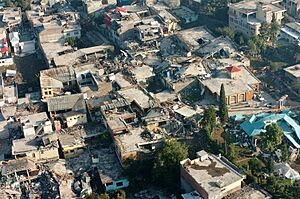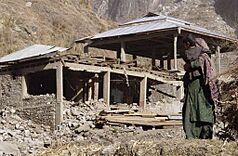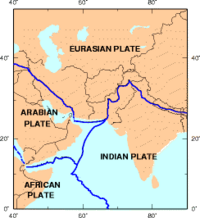2005 Kashmir earthquake facts for kids
|
|
| UTC time | 2005-10-08 03:50:40 |
|---|---|
| ISC event | 7703077 |
| USGS-ANSS | ComCat |
| Local date | 8 October 2005 |
| Local time | 08:50:39 PKT |
| Duration | 60 seconds |
| Magnitude | 7.6 Mw |
| Depth | 15 km (9.3 mi) |
| Epicenter | 34°27′N 73°39′E / 34.45°N 73.65°E |
| Type | Oblique-slip |
| Areas affected | Pakistan, India, Afghanistan |
| Max. intensity | XI (Extreme) |
| Landslides | Yes |
| Aftershocks | 5.9 Mw 8 Oct at 03:57 5.8 Mw 8 Oct at 03:58 6.4 Mw 8 Oct at 10:46 |
| Casualties | 86,000–87,351 dead 69,000–75,266 injured 2.8 million displaced |
On October 8, 2005, a powerful earthquake hit the region of Azad Jammu and Kashmir in Pakistan. It happened at 8:50 AM local time. The earthquake's center was near the city of Muzaffarabad. It also affected nearby Balakot and parts of Jammu and Kashmir in India.
The earthquake was very strong, measuring 7.6 on the moment magnitude scale. It caused extreme damage in some areas. People felt the shaking in Afghanistan, Tajikistan, India, and even the Xinjiang region. This earthquake caused a lot of damage because the ground moved upwards severely. Over 86,000 people died, and many more were injured. Millions of people lost their homes. It is known as the deadliest earthquake in South Asia.
Contents
Understanding the Earthquake
The area of Kashmir sits where two giant pieces of the Earth's crust, called Eurasian and Indian tectonic plates, are pushing against each other. This pushing and colliding is what created the huge Himalayan mountain range. It also makes the region very active with earthquakes.
The United States Geological Survey (USGS) measured this earthquake at a magnitude of 7.6. Its center was about 19 kilometers (12 miles) northeast of Muzaffarabad. This city is in Azad Jammu and Kashmir, a region controlled by Pakistan. The earthquake's center was also about 100 kilometers (62 miles) north-northeast of Pakistan's capital, Islamabad.
How Strong Was It?
The earthquake was felt very strongly, especially around its center. In areas like Muzaffarabad and Balakot, the shaking was so extreme it caused massive damage. This is measured as an XI (Extreme) on the Modified Mercalli Intensity scale. This scale describes how much people feel an earthquake and how much damage it causes.
In Balakot, buildings and other structures were heavily damaged, showing the intensity was very high. In Muzaffarabad, the shaking was rated VIII–IX (Severe–Violent). Areas south of Muzaffarabad felt it as VII–VIII (Very strong–Severe).
In India, the strongest shaking was felt in Uri, rated VIII (Destructive). It was also felt in Kupwara and Baramulla. Even in Srinagar, the earthquake was felt, though less strongly. The earthquake's tremors reached as far as Dushanbe, Tajikistan, and even slightly in Almaty, Kazakhstan.
Aftershocks and Ground Movement
After the main earthquake, many smaller earthquakes, called aftershocks, happened. Most of these were to the northwest of where the main quake started. Several strong aftershocks occurred near Muzaffarabad. By late October 2005, more than 978 aftershocks with a magnitude of 4.0 or higher had been recorded. They continued daily.
Later, satellites showed that parts of the mountains directly above the earthquake's center had actually risen by a few meters. This shows that the Himalayas are still growing and that this earthquake was a part of that natural process. By the end of 2005, a total of 1,778 aftershocks were recorded.
Damage and Impact
The earthquake caused widespread destruction and loss of life. It affected millions of people across Pakistan, India, and Afghanistan.
Impact in Pakistan

Most of the damage happened in Azad Jammu and Kashmir and other parts of Northern Pakistan. Muzaffarabad, the capital of Azad Jammu and Kashmir, was hit the hardest. Hospitals, schools, and emergency services were badly damaged or destroyed. There was almost no working infrastructure, and communication systems were broken. It's thought that over 70% of all deaths happened in Muzaffarabad. Bagh was the second most affected area.
In Islamabad, the Margalla Towers, a tall apartment building, collapsed. About 70 people died there. The official death count in Pakistan by November 2005 was 87,350, but some believe it could have been over 100,000. Around 138,000 people were injured, and over 3.5 million lost their homes.
The government reported that 19,000 children died, mostly because school buildings collapsed. More than 500,000 families were affected. Also, about 250,000 farm animals died when their stone barns fell. Many other large animals needed shelter from the coming winter. Around 200 soldiers also died in the main earthquake zone.
Since Saturday is a regular school day in the region, many students were in school when the earthquake struck. They were trapped under collapsed buildings. In Mansehra District, one school collapse killed 350 students, and another killed 50 more. Many people were also at home, taking a nap after their pre-dawn meal for Ramadan, and didn't have time to escape. Entire towns and villages in northern Pakistan were completely destroyed.
Leaders worried about a "second wave of death" if aid didn't reach remote villages quickly. These villages needed medical help, food, clean water, and shelter. Pakistan's Interior Minister, Aftab Ahmad Sherpao, asked survivors to move to valleys and cities for help. This was because bad weather, mountains, landslides, and blocked roads made it hard for rescue workers to reach everyone. Winter snows were also approaching.
Impact in India
In Jammu and Kashmir, India, at least 1,350 people died, and 6,266 were injured. Over 150 deaths occurred in Uri. The tremors were felt as far away as Delhi and Punjab.
Impact in Afghanistan
Four people died in Afghanistan. One young girl died in Jalalabad when a wall fell on her. The earthquake was felt in Kabul, but it caused very little damage there.
See also
 In Spanish: Terremoto de Cachemira de 2005 para niños
In Spanish: Terremoto de Cachemira de 2005 para niños
- Meena - "Life Smiled Again"
- Disaster Management Act, 2005
- October 2015 Hindu Kush earthquake
- 2019 Kashmir earthquake
- List of earthquakes in 2005
- List of earthquakes in Pakistan
- List of earthquakes in India
- List of earthquakes in Afghanistan








